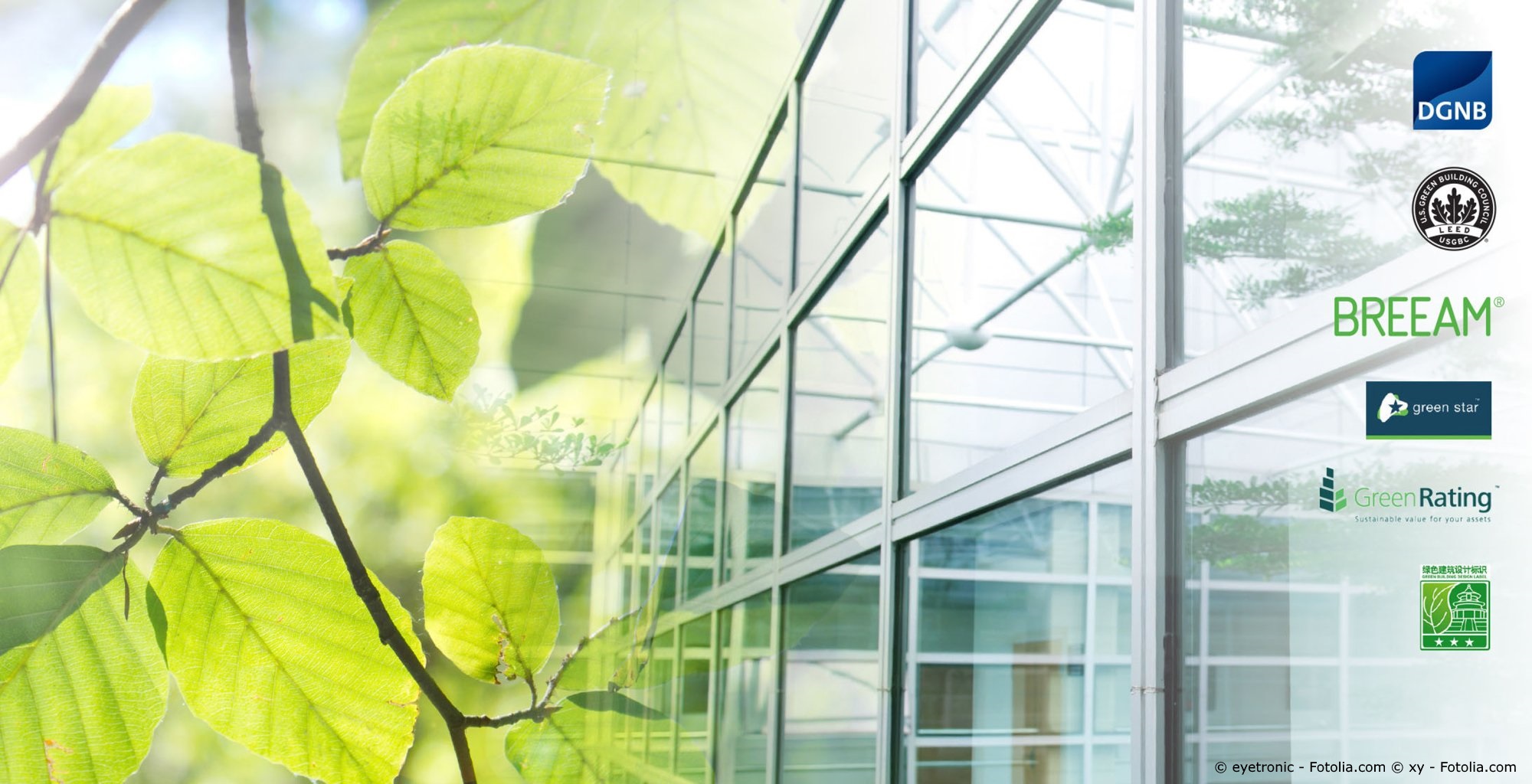Sustainable buildings, also known as green buildings, are becoming increasingly important in the construction industry. In addition to the increased quality of life for tenants and users, owners and investors also benefit from increases in the value of real estate with lower operating and maintenance costs. Due to the growing demand for green buildings, some building certification systems have been formed worldwide. DGNB, LEED and BREEAM are among the best-known rating systems in Germany. But which product requirements must sustainable construction products have to meet in order to be used in certified construction projects?
LEED (Leadership in Energy and Environmental Design)
Category Materials and Resources (LEED v4, 2015):
Credit 1: Building Life-Cycle Impact Reductions (Option 4: LCA) & Credit 2: BPDO – Environmental Product Declarations
- nformation on environmental product declarations (EPD)
Credit 3: BPDO – Sourcing of Raw Materials
- Information on raw materials and take-back programs from manufacturers, SAN, FSC, reused materials and recycling content, …
Credit 4: BPDO – Material Ingredients
- Information on the ingredients and cradle to cradle, HPD, green screen, REACH, …
Category Indoor Environmental Quality (LEED v4, 2015):
IEQ Credit 2: Low Emitting Materials – Evaluation of construction products regarding emissions
- Interior paints and coatings: Evaluation of the VOC content taking into account the LEED limit values according to SCAQMD Rule 1113, proof of a general emission measurement according to CDPH or alternative, recognized LEED standard
- Internal adhesives and sealants / sealants: Evaluation of the VOC content taking into account the LEED limit values according to SCAQMD Rule 1168, proof of a general emission measurement according to CDPH or alternative, recognized LEED standard
- Floor coverings: Evaluation of a general emission measurement according to CDPH or alternative, recognized LEED standard
- Wood-based materials: Evaluation with regard to formaldehyde (ULEF or NAUF)
- Materials for ceilings and walls, thermal and acoustic insulation: Evaluation of a general emission measurement according to CDPH or alternative, recognized LEED standard
Category Indoor Environmental Quality (Innenraumqualität) (LEED v3, 2009):
IEQ Credit 4.1 Low Emitting Materials – Adhesives and Sealants (low-emission adhesives and sealants/seals):
- Evaluation of the VOC content of adhesives and sealants taking into account the limit values of SCAQMD (South Coast Air Quality Management District Rule # 1168) and the Green Seal Standard for Commercial Adhesives GS-11, GC03.
IEQ Credit 4.2 Low Emitting Materials – Paints and Coatings (low-emission paints and coatings):
- Evaluation of the VOC content of paints and coatings taking into account the limit values of SCAQMD (South Coast Air Quality Management District Rule # 1113) and the Green Seal Standard for Commercial Adhesives GS-36.
IEQ Credit 4.3 Low Emitting Materials – Flooring Systems (Low-emission floor coverings and carpets):
- Evaluation of carpets, floor coverings, adhesives and coatings for floor coverings according to the Green Label Plus of the Carpet & Rug Institute (CRI), Floor Score Standard, SCAQMD (South Coast Air Quality Management District Rule # 1113) and the Green Seal Standard for Commercial Adhesives GS -36, SCAQMD (South Coast Air Quality Management District Rule # 1168) and the Green Seal Standard for Commercial Adhesives GS-11, GC03, GS36.
IEQ Credit 4.4 Low Emitting Materials – Composite Wood and Agrifiber Products (Wood-based materials free of formaldehyde):
- Evaluation of the absence of urea-formaldehyde in wood-based materials, such as B. in MDF boards, OSB boards or chipboard.
Category Materials and Resources (Materialien und Ressourcen) (LEED v3, 2009):
MR Credit 4: Recycled Content
- Percentage of recycled contenct.
MR Credit 5: Regional Materials
- Information on the origin and the process chain of the materials (place of manufacture, raw material extraction, processing).
MR Credit 6: Rapidly Renewable Materials
- Information on rapidly renewable components in the product (e.g. rubber, bamboo, sheep’s wool, etc.).
MR Credit 7: Certified Wood
- Assessment of the origin of the wood-based materials (tropical, subtropical, boreal, native) and the availability of the FSC certification.
DGNB (Deutsche Gesellschaft für Nachhaltiges Bauen e.V.)
Criteria ENV 1.2 Risiken für die lokale Umwelt (DGNB 2015/2018):
Assessment in the DGNB system with regard to quality levels 1-4 of paints, paints, varnishes, seals, coatings, anti-corrosion coatings, sealants, seal primers, floor coverings, insulation materials, plastics for windows, floors, wall coverings, foils, electrical cables and jackets, wood materials, aluminum and stainless steel components, doors, assembly foams, etc.
The following aspects are considered:
- Solvent (VOC content in g / l)
- Water-dilutable, solvent-free and plasticizer-free in accordance with Decopaint-RL 2004/42 / EG
- Factory primer in operation according to 31.BImSchV
- Emissions according to AgBB or equivalent (TVOC, TSVOC, …), DIN EN 717-1 or DIN EN ISO 12460-5 (formaldehyde HCHO, …)
- Certificates such as the Blue Angel (RAL-UZ 12a, RAL-UZ 102, RAL-UZ 128, RAL-UZ 113, RAL-UZ 64 or RAL-UZ 178 …), EMICODE EC1 +, EMICODE EC1, GUT seal of approval, Indoor Air Comfort Gold, natureplus, eco-INSTITUT label, TÜV Profi cert premium
- Pollutants such as chlorinated paraffins (= CP), reproduction-toxic phthalates (= SVHC according to REACH), aromatics, solvents, plasticizers (KWS plasticizers), lead, cadmium, chromium VI, tin, halogens, flame retardants, tris (2-carboxyethyl) – phosphine (= TCEP), hexabromocyclododecane (HBCD), polybrominated biphenyls (PBB) and diphenyl ether (PBDE), boron,
- GISCODE for laying materials (D1, ZP1, RU0.5, RU1, RE05, RE10, RE20, RE30, RS10), polyurethane coating / primers / adhesives (PU10, PU20, PU40, PU60), concrete release agents / formwork oils (BTM5, BTM10, BTM15, BTM20), oil and wax products (Ö10, Ö20, Ö30), PMMA and PMMA / epoxy coatings (RMA10, RMA20), epoxy resin coatings / primers, epoxy resin products (RE05, RE10, RE20, RE30, RE40, RE50 , or RE55), bituminous products (BBP10, BBP20, BBP30)
- Chemical wood protection, wood protection according to 68800-2 or natural durability according to DIN EN 350-2, marketable biocidal products according to 528/2012 / EG
Criteria ENV 1.3 Umweltverträgliche Materialgewinnung (DGNB 2015/2018):
Evaluation in the DGNB system with regard to different quality levels:
- Indication of the origin of the wood-based materials (tropical, subtropical, boreal, native) Information on the certification of the wood (FSC, PEFC- Chain of Custody, at DGNB 2018 also wood from here).
- Indication of the origin of the natural stones (European, non-EU) Information on the certification of the natural stone (CE marking, XertifiX, Fair Stone)
- Information on the extraction of concrete (CSC silver, CSC gold) at DGNB 2018
- Information about natureplus certificates for construction products
BREEAM (Building Research Establishment Environmental Assessment Method)
Critera HEA 02: Indoor air quality (BREEAM Int. 2016):
- Evaluation of construction products in terms of emissions
Criteria MAT 01: Life cycle impacts (BREEAM Int. 2016):
- Life cycle assessment and environmental product declarations (EPD)
Criteria MAT 03: Responsible sourcing of materials (BREEAM Int. 2016):
- Information on “responsible sourcing” evidence, such as reused materials, BES 6001 Framework Standard for Responsible Sourcing, CARES Sustainable Constructional Steel Scheme Concrete Custainability Council (CSC) FSC, PEFC, SFI, environmental management system ISO 14001.
You can view or request further criteria here:



 Green Building Products Increasingly In Demand
Green Building Products Increasingly In Demand
